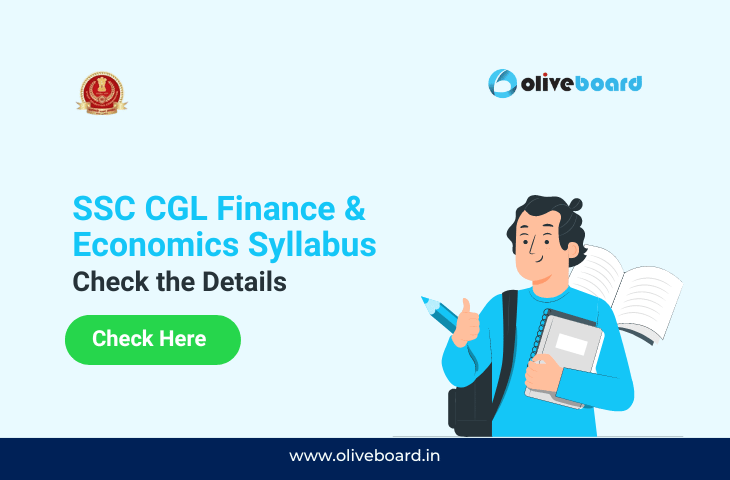SSC CGL Finance & Economics Syllabus
Candidates who apply for the post of AAO (Assistant Audit Officer/Assistant Accounts Officer) has to mandatorily appear in the Finance & Economics Paper. Tier-2 consists of this paper for the aspiring candidates. Covering topics such as public finance, macro and microeconomics, economic growth, and development, this section assesses candidates’ understanding of economic concepts and their practical applications. This blog will provide you with the SSC CGL Finance & Economics Syllabus 2023.
SSC CGL Finance & Economics Syllabus 2023
Aspiring candidates must be aware of the detailed syllabus for the Finance & Economics. We have mentioned below the detailed syllabus.
| Part | Subject | Topics |
| Part A: Finance and Accounts-(80 marks) | Financial Accounting | Nature and scopeLimitations of Financial AccountingBasic concepts and ConventionsGenerally Accepted Accounting Principles |
| Basic concepts of accounting | Single and double entryBooks of Original EntryBank ReconciliationJournal, ledgersTrial BalanceRectification of ErrorsManufacturingTradingProfit & Loss Appropriation AccountsBalance SheetDistinction between Capital and Revenue ExpenditureDepreciation AccountingValuation of InventoriesNon-profit organisations AccountsReceipts and Payments and Income & Expenditure AccountsBills of ExchangeSelf Balancing Ledgers | |
| Part B: Economics and Governance-(120 marks) | Comptroller & Auditor General of India- Constitutional provisions, Role and responsibility | |
| Finance Commission-Role and functions | ||
| Basic Concept of Economics and introduction to Micro Economics | DefinitionScope and nature of EconomicsMethods of economic studyCentral problems of an economyProduction possibilities curve | |
| Theory of Demand and Supply | Meaning and determinants of demandLaw of demand and Elasticity of demandPriceIncome and cross elasticityTheory of consumer‟s behaviourMarshallian approach and Indifference curve approachMeaning and determinants of supplyLaw of supplyThe elasticity of Supply | |
| Theory of Production and cost | Meaning and Factors of productionLaws of production- Law of variable proportions and Laws of returns to scale. | |
| Forms of Market and price determination in different markets | Various forms of markets-Perfect CompetitionMonopolyMonopolistic CompetitionOligopolyPrice determination in these markets. | |
| Indian Economy | Nature of the Indian Economy Role of different sectors, Role of Agriculture, Industry and Services-their problems and growth.National Income of India-Concepts of national income, Different methods of measuring national income.Population-Its size, rate of growth and its implication on economic growth.Poverty and unemployment- Absolute and relative poverty, types, causes and incidence of unemployment.Infrastructure-Energy, Transportation, Communication. | |
| Economic Reforms in India | Economic reforms since 1991LiberalisationPrivatisationGlobalisationDisinvestment | |
| Money and Banking | Monetary/ Fiscal policy- Role and functions of Reserve Bank of India; functions of commercial Banks/RRB/Payment Banks.Budget and Fiscal deficits and Balance of payments.Fiscal Responsibility and Budget Management Act, 2003. | |
| Role of Information Technology in Governance |
Finance & Economics Syllabus – Important Points
The Finance and Economics syllabus in SSC CGL preparation holds immense importance for several compelling reasons:
- Policy Insights: Understanding economic theories equips candidates to analyze government policies, aiding in roles involving policy formulation, evaluation, and decision-making.
- Relevance in Government Roles: Many government positions require an understanding of financial management and economic principles, making this syllabus directly applicable to real-world scenarios.
- Economic Growth Awareness: Mastery of economic concepts helps candidates comprehend factors driving economic growth, contributing to a comprehensive understanding of economic development.
- Macroeconomic Understanding: Learning about macroeconomics provides insight into national economies, monetary policies, fiscal strategies, and their implications—relevant in diverse government job roles.
- Scoring Potential: Strong performance in this section enhances overall scores and ranking, significantly influencing the chances of securing a coveted government job.
- Tier II Exam: Finance and Economics syllabus is part of the Tier II exam. Proficiency in these topics is beneficial for the advanced stage of the examination.
- Data Interpretation: Economic analysis often involves interpreting statistical data. Candidates skilled in this syllabus are better equipped to analyze and draw meaningful conclusions from economic data.
- Career Advancement: Proficiency in Finance and Economics is an asset for government roles requiring financial management, economic analysis, and public policy evaluation.
Conclusion
We hope this blog gave you a better understanding of the SSC CGL Finance & Economics Syllabus 2023. To read more such blogs, visit the Oliveboard website!
- SSC CHSL 2024 Apply Online, CHSL Application Form Link
- SSC CGL Salary 2024, Check Perks, Allowances and Benefits
- RBI Grade B Online Coaching 2024, All RBI Grade B Courses
- SSC CGL Notification 2024, Release Date, Download PDF
- IBPS RRB PO Salary 2024, Pay Scale, Salary Structure
SSC CGL Finance & Economics Syllabus 2023 – FAQs
Ans. Candidates can check the detailed Finance & Economics Syllabus 2023 in this blog.
Ans. No, Finance & Economics Paper is only mandatory for candidates who have applied for the post of AAO.

Hey everyone, I’m Vaishnavi Kumari, an edtech writer and a dedicated aspirant for government exams, including banking and SSC exams. Having worked with several edtech platforms, I am committed to providing you with essential and accurate information to ace these exams. With my experience as both a writer and an aspirant, I understand your needs and challenges, and my aim is to make your preparation journey smoother. I’ll focus on specific sections of the exams, compiling comprehensive and helpful content that covers the crucial topics, tips, and strategies you need to succeed. Let’s conquer these exams together!
Oliveboard Live Courses & Mock Test Series



